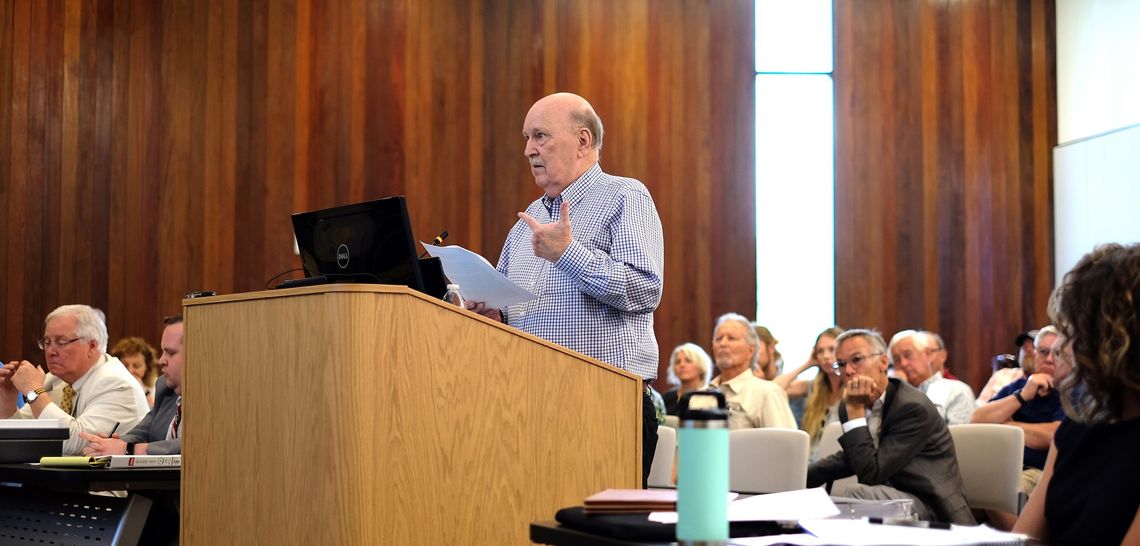District OKs massive annual water production permit
After six hours of grueling debate Monday, Barton Springs Edwards Aquifer Conservation District (BSEACD) leaders approved Needmore Ranch LLC’s permit to pump 289 million gallons of water annually from the Trinity Aquifer.
The decision, made by a 5-0 vote by the BSEACD board of directors, gives Needmore, a Wimberley-area entity, the largest water production permit in the district. Approval included special conditions that require Needmore to cut back pumping if drawdown reaches certain trigger levels in an index well.
BSEACD leaders approved Needmore Ranch LLC’s permit to pump 289 million gallons of water annually from the Trinity Aquifer.
Additionally, a separate condition would allow staff to require Needmore to permanently reduce pumping if unreasonable impacts on other wells occur. Needmore must also pay $2,500 annually to help offset monitoring costs.
“This is the most difficult permit this district has ever had,” Director Mary Stone said. “I don’t think anyone in the district would want to limit anyone (to pump their water). At the same time, we have a responsibility to ensure everyone’s water is available and is protected at the highest quality…with the special conditions, I believe that will happen.”
The approval marked a defeat for local property owners who worried about the logistics of the permit. Many residents felt the permit could cause an unreasonable impact on the aquifer and neighboring wells.
Approval of the permit also highlighted a flaw in House Bill 3405, known as the Save our Wells bill, which was passed by the state legislature in 2015.
HB 3405 extended the jurisdiction of the BSEACD to a previously unregulated area of the Trinity Aquifer. Half of Needmore Ranch, however, was in an unregulated portion of the district before the bill became law.
A loophole in HB 3405 created a process where landowners operating a well before the passage of the law could apply for a production permit for the “maximin production capacity” of said well. That allows an applicant to go for the maximum threshold of pumping, a departure from what the board is used to.
Ed and Eddy McCarthy, Needmore’s legal team, argued the ranch had a well before HB 3405 became law in June 2015, which means the applicant is eligible for a permit.
BSEACD Senior Hydrogeologist Brian Hunt said Needmore conducted an aquifer test pumping 550 gallons per minute operating 24 hours a day.
Based on the test, 289 million gallons per year was an appropriate threshold for the permit.
Frustration from the dais
Needmore’s request meant the board was working in opposition to typical practice.
During deliberation, Stone felt the limitations of HB 3405 made the process “ass-backward.” Stone was critical of Needmore and the permit, but conceded their hands were tied.
Ultimately, the board felt the recommendation from staff was the best shot for protecting the aquifer in the future.
President Blayne Stansberry said “the statute limited how the board looked at it,” but that the board thought “the special conditions are protective of the aquifer.”
The board entered executive session to consult with its general counsel twice throughout the six-hour meeting on the legality of the permit.
Officials with the Trinity Edwards Springs Protection Agency (TESPA), which has opposed Needmore’s permit, said in a statement they were extremely disappointed with the decision by the board.
However, TESPA officials said HB 3405 restrictions do not apply to a permit request from Electro Purification, which is seeking to pump close to 1 billion gallons of water from the Trinity Aquifer, giving the board more leeway in its action.
“It is our hope that special conditions do not become a precedent for the district to avoid denying or substantially reducing a permit when it is clear that the permit will unreasonably impact other well owners,” According to the statement.
Landowners express worry about permit
Prior to a decision, landowners cited their concerns with the permit and costs to affected wells and the intent of the applicant.
Needmore’s permit is the first active agriculture permit in the district. But landowners question how the Needmore Ranch will need 289 million a year for the use of agriculture.
Additionally, landowners said that, if wells were to go dry because of this permit, people having to purchase rainwater collection systems. The price of such a system is upwards of $100,000, which is out of the range of those on fixed incomes.
Local resident Louis Bond said the district’s sole purpose is to protect the aquifer. Bond said landowners are not fighting to pump as much water as they can because they have a respect for the natural resources in the area.
“What if the rest of us said we’re going to grab the water and pump as much as I could,” she asked. “Any one of us could do that, but we don’t … I have nothing to gain from (the permit), but everything to lose.”










